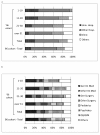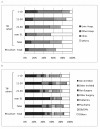Retention rate of physicians in public health administration agencies and their career paths in Japan
- PMID: 20416093
- PMCID: PMC2877024
- DOI: 10.1186/1472-6963-10-101
Retention rate of physicians in public health administration agencies and their career paths in Japan
Abstract
Background: Physicians who serve as public health specialists at public health centers and health departments in local or central government have significant roles because of their public health expertise. The aim of this study is to analyze the retention and career paths of such specialists in Japan.
Method: We analyzed the data of seven consecutive surveys, spanning 1994 to 2006. We first analyzed the 2006 survey data by sex, age group, and facility type. We then examined the changes over time in the proportion of physicians working in public health administration agencies. We also examined the distribution of the facility types and specialties in which physicians worked both before beginning and after leaving their jobs. These analyses were performed by using physician registration numbers to cross-link data from two consecutive surveys.
Results: The proportion of physicians working in public health administration agencies was 0.7% in 2006. The actual numbers for each survey ranged between 1,800 and 1,900. The overall rate remaining in public health administration agencies during the two-year survey interval was 72.8% for 1994-1996. The ratio declined to 67.2% for 2004-2006. Among younger physicians with 1-10 years of experience, the retention rate showed a sharp decline, dropping from 72.6% to 50.0%. Many of these physicians came from or left for a hospital position, with the proportion entering academic hospital institutions increasing in recent years. In many cases, physicians left or entered internal medicine clinical practices.
Conclusion: At present in Japan, the number of physicians who leave and the number who begin a position are almost the same; thus, some of the problems associated with physicians leaving are yet to become apparent. However, the fact that the retention period is shortening for younger physicians may represent a future problem for ensuring the quality of physicians in public health administration agencies. Possible strategies include: increasing the number of physicians entering positions; reducing the number leaving positions; and creating a system where physicians can easily reenter positions after leaving while also establishing a revolving door type of career development system, involving both public health departments and hospital clinical departments.
Figures



Similar articles
-
Factors related to the resignation and migration of physicians in public health administration agencies using nationwide survey data in Japan.BMC Health Serv Res. 2023 Oct 24;23(1):1143. doi: 10.1186/s12913-023-10085-7. BMC Health Serv Res. 2023. PMID: 37875901 Free PMC article.
-
Physician retention in community and migrant health centers: who stays and for how long?Med Care. 1998 Aug;36(8):1198-213. doi: 10.1097/00005650-199808000-00008. Med Care. 1998. PMID: 9708592
-
Medical doctors profile in Ethiopia: production, attrition and retention. In memory of 100-years Ethiopian modern medicine & the new Ethiopian millennium.Ethiop Med J. 2008 Jan;46 Suppl 1:1-77. Ethiop Med J. 2008. PMID: 18709707
-
Career preferences and the work-family balance in medicine: gender differences among medical specialists.Soc Sci Med. 2000 May;50(9):1235-46. doi: 10.1016/s0277-9536(99)00363-9. Soc Sci Med. 2000. PMID: 10728844 Review.
-
Mid-career changes in the occupation or specialty among general surgeons, from youth to middle age, have accelerated the shortage of general surgeons in Japan.Surg Today. 2014 Apr;44(4):601-6. doi: 10.1007/s00595-013-0613-6. Epub 2013 May 28. Surg Today. 2014. PMID: 23712727 Review.
Cited by
-
Distribution and retention trends of physician-scientists in Japan: a longitudinal study.BMC Med Educ. 2019 Oct 28;19(1):394. doi: 10.1186/s12909-019-1840-3. BMC Med Educ. 2019. PMID: 31660958 Free PMC article.
-
Factors associated with the non-retention of health sector employees recruited in Iran: a survival analysis.BMC Health Serv Res. 2024 Aug 19;24(1):942. doi: 10.1186/s12913-024-11355-8. BMC Health Serv Res. 2024. PMID: 39160524 Free PMC article.
-
Factors related to the resignation and migration of physicians in public health administration agencies using nationwide survey data in Japan.BMC Health Serv Res. 2023 Oct 24;23(1):1143. doi: 10.1186/s12913-023-10085-7. BMC Health Serv Res. 2023. PMID: 37875901 Free PMC article.
-
Career Paths of Public Health Medicine Specialists in South Africa.Front Public Health. 2019 Sep 12;7:261. doi: 10.3389/fpubh.2019.00261. eCollection 2019. Front Public Health. 2019. PMID: 31572703 Free PMC article.
References
-
- World Health Organization. WHO Global Recommendations for the Retention of Health Workers. http://www.who.int/hrh/migration/retention/en/index.html
-
- World Health Organization. The World Health Report 2006: Working Together for Health. Geneva. 2006. - PubMed
-
- Tachibana T, Takemura S, Sone T, Segami K, Kato N. Competence necessary for Japanese public health center directors responding to public health emergencies. Jpn J Publ Health [Nippon Koshu Eisei Zasshi] 2005;52(11):943–956. - PubMed
-
- Japanese Association of Public Health Center Directors. Trends in the Number of Public Health Centers 2009. http://www.phcd.jp/gaiyou/gaiyou.html (In Japanese)
Publication types
MeSH terms
LinkOut - more resources
Full Text Sources

